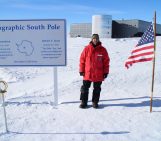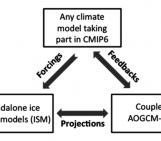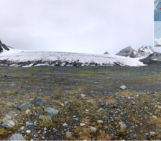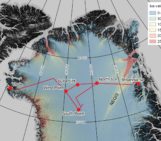
Fig. 1: Map of ice velocity from the NASA MEaSUREs Program showing the region of Enderby Land in East Antarctica [Credit: Fig. 1 from Kallenberg et al. (2017) ].
Mass balance of ice sheets
The mass balance of an ice sheet is the difference between the mass gain of ice, primarily through snowfall, and the mass loss of ice, primarily via meltwater runoff and ice dynamic processes (e.g. iceberg calving, melting below ice shelves). When the mass gain is equal to the mass loss, the ice sheet is in balance. However, if one exceeds the other, the ice sheet either gains or loses mass.
Measuring mass balance changes of ice sheets is crucial due to their potential contribution to sea level rise (see previous post). You can have a look at this nice review for further details about the recent changes in the mass balance of the two biggest ice sheets on Earth, i.e. Antarctica and Greenland.
Ice mass changes from snowfall and meltwater runoff (what we call ‘surface mass balance’ changes) are reasonably well simulated by regional climate models, which give good agreement with observations (see this study for Antarctica and this one for Greenland). Mass changes from ice dynamics are more complex to obtain. They are commonly estimated by combining ice velocity and ice thickness. Ice velocity is measured via satellite radar interferometry, while ice thickness is obtained thanks to airborne radar. Unfortunately, these measurements have sparse temporal and spatial coverage, especially in Antarctica, which makes the computation of mass changes from ice dynamics challenging.
A new method to estimate ice dynamic changes
Kallenberg et al. (2017) conducted a study focussing on Enderby Land in East Antarctica (see our Image of the Week) in which they use a novel approach to estimate ice dynamic changes. This region of Antarctica has experienced a slightly positive mass balance in past years, meaning that the ice sheet has slightly thickened in this region.
Kallenberg et al. (2017) first used satellite observations to compute the total changes in ice sheet mass. They took advantage of two high-technology datasets. The first one, “Gravity Recovery And Climate Experiment” (GRACE), measures changes in the Earth’s gravity field, from which ice mass changes can be derived. A summary explaining how GRACE works can be found in this previous post. The second satellite dataset, “Ice, Cloud, and land Elevation Satellite” (ICESat), measures changes in ice surface elevation, from which changes in ice mass can be computed by using ice density.
However, Kallenberg et al. (2017) were not interested in the total ice mass changes, as obtained from GRACE and ICESat satellites, but rather in ice dynamic changes. They subtracted two quantities from the total mass changes in order to obtain the remaining dynamic changes:
- Surface mass balance changes: changes from processes happening at the surface of the ice sheet (e.g. snow accumulation, meltwater runoff). These changes were obtained from model simulations using the Regional Atmospheric Climate Model (RACMO2), for which details can be found in this previous post.
- Glacial Isostatic Adjustment: changes in land topography due to ice loading and unloading. These changes were computed from Glacial Isostatic Adjustment models.
What does this study tell us?
The results of this study show that it is possible to compute changes in ice mass resulting from ice dynamics with higher spatial and temporal coverage than before, using a combination of satellite observations and models.
Also, the use of two different satellite datasets (GRACE and ICESat) shows that they agree quite well with each other in the region of Enderby Land (see Fig. 2). This means that using one or the other dataset does not make a big difference.
Finally, this new method also shows that differences between GRACE and ICESat reduce when using the newer version of RACMO2 for computing surface mass balance changes. This tells us that comparing results of ice dynamics from both satellites with different models is a good way to identify which models correctly simulate surface processes and which models do not.
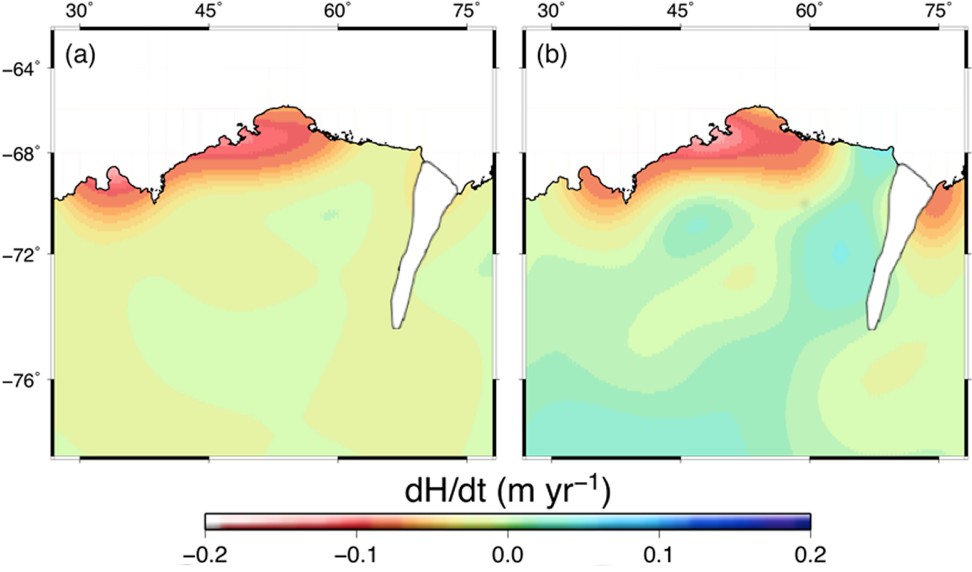
Fig. 2: Ice dynamic changes (dH/dt, where H is ice thickness and t is time) computed from (a) GRACE and (b) ICESat and expressed in meters per year [Credit: Fig. 5 from Kallenberg et al. (2017) ].
Further reading
- Kallenberg, B., P. Tregoning, J. F. Hoffmann, R. Hawkins, A. Purcell, and S. Allgeyer (2017). A new approach to estimate ice dynamic rates using satellite observations in East Antarctica, The Cryosphere, 11, 1235-1245, doi: 10.5194/tc-11-1235-2017.
- Hanna, E., F. J. Navarro, F. Pattyn, C. M. Domingues, X. Fettweis, E. R. Ivins, R. J. Nicholls, C. Ritz, B. Smith, S. Tulaczyk, P. L. Whitehouse, and H. J. Zwally (2013). Ice-sheet mass balance and climate change. Nature, 498, 51-59, doi: 10.1038/nature12238.
- Image of the Week – Antarctica’s Flowing Ice, Year by Year
- Image of the Week – A high-resolution picture of Greenland’s surface mass balance
- Marine Ice Sheet Instability “For Dummies”
Edited by Clara Burgard and Emma Smith
 David Docquier is a post-doctoral researcher at the Earth and Life Institute of Université catholique de Louvain (UCL) in Belgium. He works on the development of processed-based sea-ice metrics in order to improve the evaluation of global climate models (GCMs). His study is embedded within the EU Horizon 2020 PRIMAVERA project, which aims at developing a new generation of high-resolution GCMs to better represent the climate.
David Docquier is a post-doctoral researcher at the Earth and Life Institute of Université catholique de Louvain (UCL) in Belgium. He works on the development of processed-based sea-ice metrics in order to improve the evaluation of global climate models (GCMs). His study is embedded within the EU Horizon 2020 PRIMAVERA project, which aims at developing a new generation of high-resolution GCMs to better represent the climate.

